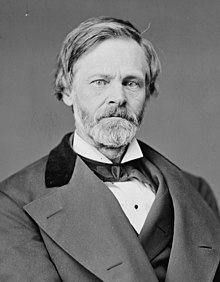
Back جون شيرمان Arabic جون شيرمان ARZ جان شرمن AZB Джон Шэрман Byelorussian জন শেরম্যান Bengali/Bangla John Sherman Danish John Sherman German John Sherman Spanish جان شرمن Persian John Sherman Finnish
John Sherman | |
|---|---|
 Photograph by Mathew Brady, 1865–1880 | |
| 35th United States Secretary of State | |
| In office March 6, 1897 – April 27, 1898 | |
| President | William McKinley |
| Preceded by | Richard Olney |
| Succeeded by | William R. Day |
| Chairman of the Senate Republican Conference | |
| In office September 2, 1884 – December 1885 | |
| Preceded by | Henry B. Anthony |
| Succeeded by | George F. Edmunds |
| In office December 1891 – March 4, 1897 | |
| Preceded by | George F. Edmunds |
| Succeeded by | William B. Allison |
| President pro tempore of the United States Senate | |
| In office December 7, 1885 – February 26, 1887 | |
| Preceded by | George F. Edmunds |
| Succeeded by | John James Ingalls |
| United States Senator from Ohio | |
| In office March 4, 1881 – March 4, 1897 | |
| Preceded by | Allen G. Thurman |
| Succeeded by | Mark Hanna |
| In office March 21, 1861 – March 8, 1877 | |
| Preceded by | Salmon P. Chase |
| Succeeded by | Stanley Matthews |
| 32nd United States Secretary of the Treasury | |
| In office March 10, 1877 – March 3, 1881 | |
| President | Rutherford B. Hayes |
| Preceded by | Lot M. Morrill |
| Succeeded by | William Windom |
| Member of the U.S. House of Representatives from Ohio's 13th district | |
| In office March 4, 1855 – March 21, 1861 | |
| Preceded by | William D. Lindsley |
| Succeeded by | Samuel T. Worcester |
| Personal details | |
| Born | May 10, 1823 Lancaster, Ohio, U.S. |
| Died | October 22, 1900 (aged 77) Washington, D.C., U.S. |
| Resting place | Mansfield City Cemetery |
| Political party |
|
| Spouse |
Margaret Stewart (m. 1848) |
| Children | Mary Sherman (adopted) |
| Relatives |
|
| Signature | |
John Sherman (May 10, 1823 – October 22, 1900) was an American politician from Ohio who served in federal office throughout the Civil War and into the late nineteenth century. A member of the Republican Party, he served in both houses of the U.S. Congress. He also served as Secretary of the Treasury and Secretary of State. Sherman sought the Republican presidential nomination three times, coming closest in 1888, but was never chosen by the party.
Born in Lancaster, Ohio, Sherman later moved to Mansfield, Ohio, where he began a law career before entering politics. He was the younger brother of Union general William Tecumseh Sherman, with whom he had a close relationship. Initially a Whig, Sherman was among those anti-slavery activists who formed what became the Republican Party. He served three terms in the House of Representatives. As a member of the House, Sherman traveled to Kansas to investigate the unrest between pro- and anti-slavery partisans there. He rose in party leadership and was nearly elected Speaker in 1859. Sherman was elected to the Senate in 1861. As a senator, he was a leader in financial matters, helping to redesign the United States' monetary system to meet the needs of a nation torn apart by civil war. He also served as the Chair of the Senate Agriculture Committee during his 32 years in the Senate. After the war, he worked to produce legislation that would restore the nation's credit abroad and produce a stable, gold-backed currency at home.
Serving as Secretary of the Treasury in the administration of Rutherford B. Hayes, Sherman continued his efforts for financial stability and solvency, overseeing an end to wartime inflationary measures and a return to gold-backed money. He returned to the Senate after his term expired, serving there for a further sixteen years. During that time he continued his work on financial legislation, as well as writing and debating laws on immigration, business competition law, and the regulation of interstate commerce. Sherman was the principal author of the Sherman Antitrust Act, which was signed into law by President Benjamin Harrison in 1890. In 1897, President William McKinley appointed him Secretary of State. Failing health and declining faculties made him unable to handle the burdens of the job, and he retired in 1898 at the start of the Spanish–American War. Sherman died at his home in Washington, D.C., in 1900 at age 77.